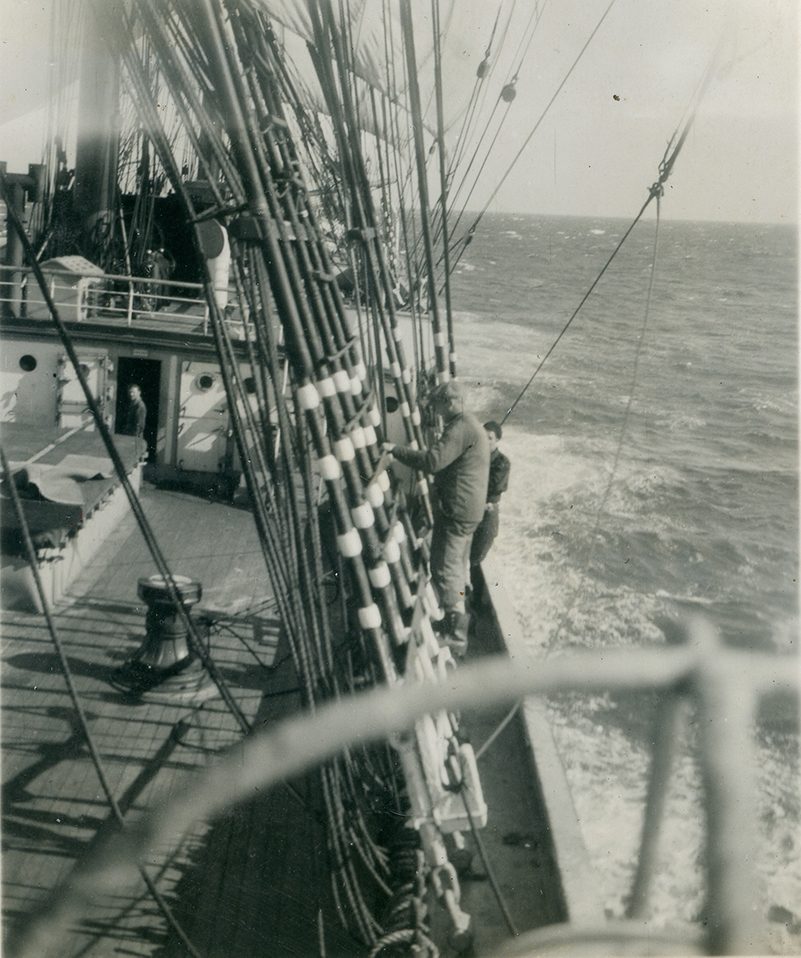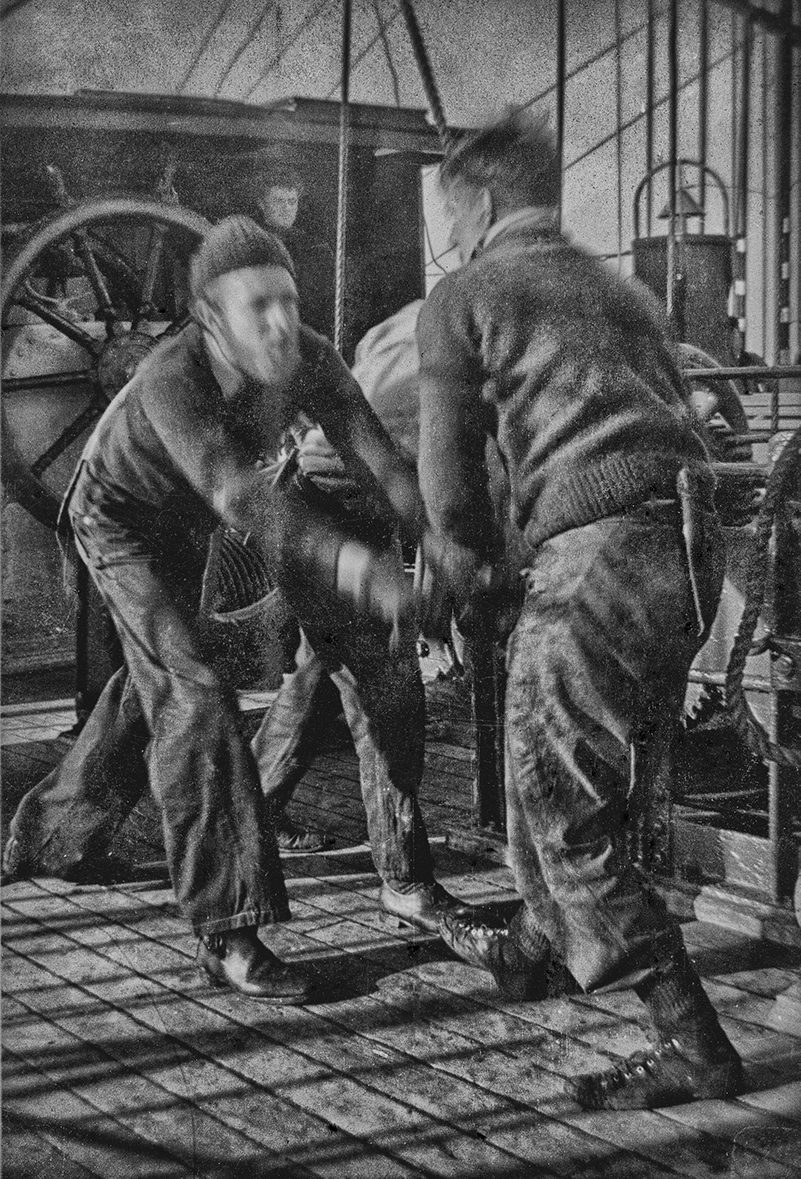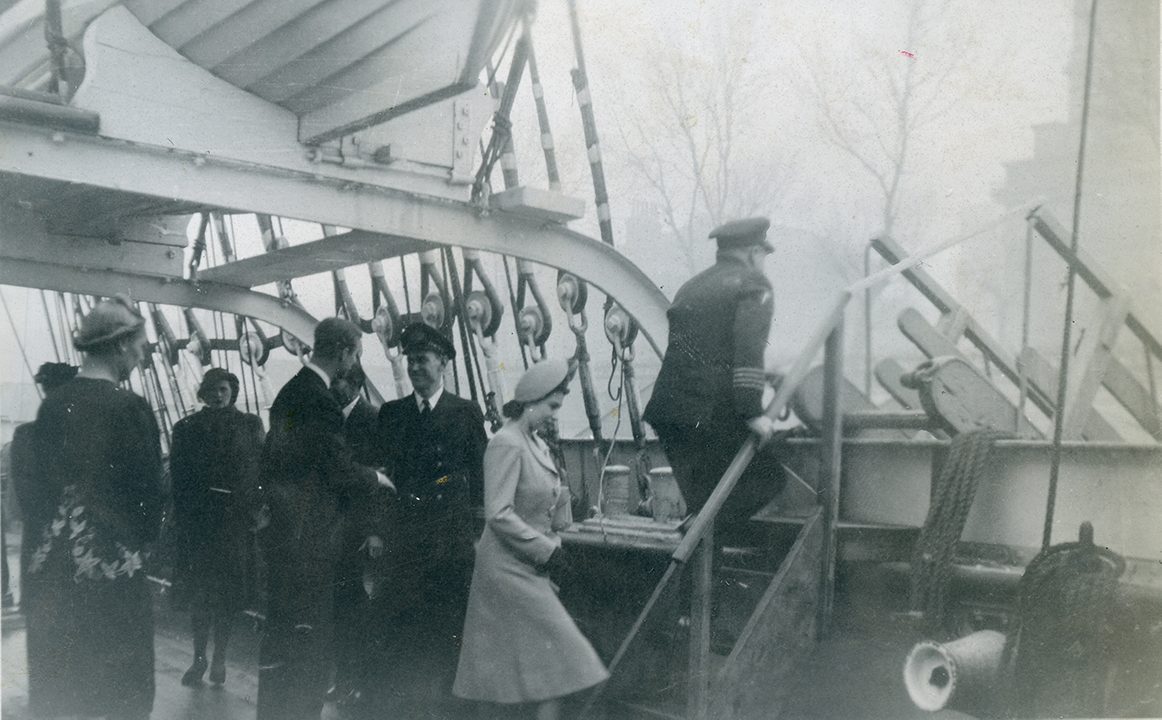

When a young Malcolm Pearson went to sea the world was a different place. It was a time after WWII, but before the rise of precision timing, just-in-time delivery and the madness of the high-speed world. Also a time when it was still (just) economic to run a cargo ship under sail. Story by Matt Vance.
The Pamir was a four-masted barque of the Flying P Line, founded in 1824 by German businessman Ferdinand Laeisz. Its ships were well known for speed and reliability and having names all starting with the letter ‘P’.
With the opening of the Suez and Panama canals, the steamship was destined to leapfrog sailing ships. The only obstacle was that steam required vast amounts of coal and coal ports within reach of each other to work. Pamir required none of that filthy business and had a huge cargo capacity as her holds weren’t restricted by the bulk of a steam engine and bunkers.

During WWII the Pamir had been seized by the New Zealand Government from Germany as a prize of war. Under the New Zealand flag, she made 10 commercial voyages as a bulk carrier and was spared the torpedo in 1943 when the commander of the Japanese sub who had her in his sights considered in his wisdom that she would be of little value.
It was when the Pamir lay in Wellington in 1946 that Pearson got his first sight of her. In those days employment at sea was done under the ‘corner’ system. The corner referred to the shipping office where sailors went to apply for work.
“The call would be put out and if you were qualified for the position you stood for it. The Chief mate would eyeball the line of sailors and pick out the ones he thought would be up to the job,” says Pearson.
With the Pamir bound for Vancouver Malcolm decided to approach her skipper, Des Champion, personally with a reference from the captain’s brother Roy who had been a friend of his seafaring father.
Des took a shine to a Pearson, noted his last discharges showed good marks in conduct, ability and sobriety and offered him a position as Deck Boy, shipping out later in the afternoon.
“I hadn’t bought my gear with me from Christchurch – never believing I’d get the opportunity to sail on a tall ship.” The young Pearson had learned a big lesson about being prepared for opportunity when she knocks.
After some more sea time under his belt on steamers, the next opportunity he got to sign up for work on the Pamir was a different story. “When I got picked by the chief mate at the corner I near floated out the door,” recalls Malcolm.

He shipped out as Deck Boy from Wellington to Lyttelton under Captain Collier or ‘Two-Gun Pete’ as he was known. It took 12 days and the ship was walloped by a sou’wester just as she entered the harbour.
“The first night I was aboard in Wellington I asked if I could go up the main mast via the rigging. I got as far as the first set of shrouds where you have to do a small bit of it with a backward incline at the futtocks. That was enough for me and I wondered if I’d bitten off more than I could chew.” But he soon learned the ropes, and as Pamir had no less than 17 miles of running rigging there was plenty to learn.
By today’s frantic standards a tall ship could spend a long time in port. “We were in Sydney for two months and they had us right downtown at Circular Quay as we could not fit our masts under the bridge.
“There was always maintenance work to do but sometimes we hankered for a challenge. We were watching the workers on the Sydney harbour bridge and decided to jump the security fence and wander up onto the top span.”

While in the port they were the flagship for the annual Sydney Harbour Regatta and part of their duties was to host a dance on board. Pearson recalls: “I wasn’t much into dancing so me and Jimmy Jeffries found a bottle of gin and hid in the mess room. The dinner was in the shed next to us on the quay and had some of the Pamir’s sails laid out on the floor for repair.
“We had to do duty in the supper shed to make sure no one dropped cigarette butts on our sails and during my shift later in the night the room started spinning and I threw up on the upper spanker right in front of Two-Gun and an eminent lady guest. The stain lasted almost as long as the bollocking I got from the old man.”
The Pamir returned to Wellington in 1947 with a load of cement before embarking on a voyage to London via Cape Horn with a cargo of wool, tallow and hides. It was the trip of a lifetime for a young sailor. “We dove south quickly and only started to put a bit of westing in once we were well south of the Chathams.”
What does he remember most about the Southern Ocean and the 27 days it took to get to the Horn? “The cold.” Gloves were frowned upon and even illegal to wear on some ships and the cold weather clothing was minimal by today’s standards.
“There was the pain before your hands went numb and the pain as they thawed out after working in the rigging,” says Pearson. The cold made the four-hour watches an ordeal if it coincided with sail changes.
“After all that we did not sight the Horn as we were 180 miles south of it but we did see a few bergs. The thought of piling into one of those in the night did not bear thinking about and for that reason old Two-Gun ordered the royals taken in at dusk so we had some chance of manoeuvring out of the way if we needed to.”

After 79 days the Pamir arrived in London and was towed to Victoria Docks. “I was amazed at the bombed-out buildings from the war and the awful state of the water which you could nearly walk on,” he remembers.
A recently married Princess Elizabeth II and the Duke of Edinburgh visited the Pamir while she was at the docks and were escorted around the ship by Two-Gun in his number ones. Pearson and Jimmy Jeffries had learned their lesson and kept away from the gin and the upper spanker on this auspicious occasion.
After a spell in London, Pamir was towed over to Antwerp through a still-active minefield. “As we left the Victoria docks there was a mess-up with the tug and we near took out a power pole with our bowsprit. While we were waiting for another tug to untangle us my twin brother Maurice arrived on a steamer and was able to have a catch up with me from the wharf.”
With a load of slag aboard, Pamir was towed out to the English Channel and commenced a 110-day voyage to Auckland via the Cape of Good Hope. This would be one of the last circumnavigations by a commercial sailing ship.
How did she sail?
Pearson’s eyes light up: “Steering upwind or on a reach in good weather was a delight, a spoke or two was all that was needed to keep her on course. But downwind in heavy weather she was a pig to steer, needing four sailors on two wheels to keep her under control. If you broached and she went aback you could lose the entire rig so there was always a bit of trepidation at the wheel in those conditions.”
As for life on the yards? “You got used to it,” says Pearson with a shrug. “George Gunn was the only fellow I knew to fall off on a voyage. Luckily for him, it was flat calm and he fell in the water and not on the deck. He was picked by the ship’s boat and she carried on.”

After the Pamir Pearson spent many more years at sea in steamers, a short stint ashore as a shopkeeper and fisherman in Little Akaroa before spending the last 18 years of his career as Captain of one of the Melbourne cement ships that worked out of Westport.
In 1957, long after he’d left the Pamir and under her original German flag, she foundered in Hurricane Carrie when her load of barley shifted, causing her to capsize. Of a crew of 86 and with 52 young cadets aboard, only four crew and two cadets were found alive in a lifeboat.

“I shed a tear when I heard about the loss of the Pamir. What a tragic waste of young life,” says Pearson.
Malcolm Pearson QSM is the last person alive to ever sail around Cape Horn in a commercial sailing ship. Sailors, raise your glass.





